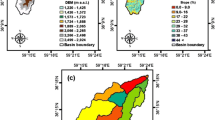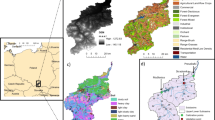Abstract
This study's objectives include simulating and quantifying the sediment production from a data-scarce north-western Himalayan Lidder river basin using the SWAT model and providing baseline data and projections of future changes in the sediment yield in response to climate change. The model performed well for monthly streamflow simulation based on R2 and NSE values of 0.72 and 0.85, respectively, for calibration and R2 of 0.8 and NSE of 0.6 for validation. For simulation of future sediment yield, the future climate in the basin was projected using bias-adjusted RCM Cordex data with a geographical resolution of 0.44° under the medium (RCP4.5) and high (RCP8.5) emission scenarios. Assessment of climate change on sediment yield is determined for three time zones early (2010–2039), mid (20,140–2069) and late century (2070–2099). Climate change is having a significant influence on water resources. The observed average annual precipitation shows a decreasing trend from 1262 to 934 mm for the late century. Precipitation is expected to decrease by 11.98–14.59% for RCP 4.5 and 3.54–9.75% for RCP 8.5. The maximum and minimum temperature has shown an increasing trend under both RCPs with a higher increase in RCP 8.5. The maximum temperature is anticipated to increase by 1.69–3.97 °C for RCP 4.5 and 1.87–7.02 °C for RCP 8.5. Likewise, the minimum temperature is expected to increase by 1.79–3.87 °C for RCP 4.5 and 1.97–7.09 °C for RCP 8.5. The findings show that future sediment yield is anticipated to decline at all stations for RCP 4.5 and RCP 8.5, with a greater decline in RCP 4.5, demonstrating that precipitation significantly affects sediment yield generation in the basin.
Zusammenfassung
Zu den Zielen dieser Studie gehören die Simulation und Quantifizierung der
Sedimentproduktion in einem datenarmen Einzugsgebiet der Lidder im Nordwesten des Himalaya mit Hilfe des
SWAT-Modells sowie die Bereitstellung von Basisdaten und Projektionen künftiger Veränderungen des
Sedimentaufkommens als Reaktion auf den Klimawandel. Das Modell schnitt bei der Simulation des monatlichen
Abflusses mit R2- und NSE-Werten von 0,72 bzw. 0,85 für die Kalibrierung und R2 von 0,8 und NSE von 0,6 für die
Validierung gut ab. Für die Simulation der zukünftigen Sedimentausbeute wurde das zukünftige Klima im
Einzugsgebiet mit Hilfe von verzerrungsbereinigten RCM-Cordex-Daten mit einer geografischen Auflösung von
0,44° unter den mittleren (RCP 4,5) und hohen (RCP 8,5) Emissionsszenarien projiziert. Die Auswirkungen des
Klimawandels auf die Sedimentausbeute werden für die drei Zeitzonen Anfang (2010-2039), Mitte (2040-2069) und
Ende des Jahrhunderts (2070-2099) ermittelt. Der Klimawandel hat einen erheblichen Einfluss auf die
Wasserressourcen. Der beobachtete durchschnittliche Jahresniederschlag zeigt für das späte Jahrhundert einen
rückläufigen Trend von 1262 mm auf 934 mm. Es wird erwartet, dass die Niederschläge bei RCP 4.5 um 11,98-
14,59 % und bei RCP 8.5 um 3,54-9,75 % abnehmen werden. Die Maximal- und Minimaltemperaturen zeigen bei
beiden RCPs einen steigenden Trend, wobei der Anstieg bei RCP 8.5 höher ist. Die Höchsttemperatur wird
voraussichtlich um 1,69-3,97 °C für RCP 4,5 und um 1,87-7,02 °C für RCP 8,5 ansteigen. Ebenso wird erwartet,
dass die Minimaltemperatur um 1,79-3,87 °C für RCP 4,5 und 1,97-7,09 °C für RCP 8,5 ansteigen wird. Die
Ergebnisse zeigen, dass der künftige Sedimentertrag an allen Stationen für RCP 4,5 und RCP 8,5 zurückgehen
wird, wobei der Rückgang bei RCP 4,5 stärker ausfällt, was zeigt, dass die Niederschläge die Sedimenterzeugung
im Einzugsgebiet erheblich beeinflussen.





Similar content being viewed by others
Data Availability
Daily metrological data were obtained from Indian Meteorological Data (IMD), Pune, and measured data of stages and corresponding discharge for the gauging stations were obtained from the department of irrigation and flood control, Kashmir.
References
Arnold JG, Srinivasan R, Muttiah RS, Williams JR (1998) Large-area hydrologic modeling and assessment: Part I. Model development. J Am Water Resour Assoc 34(1):73–89
Barfield BJ, Hayes JC, Stevens E, Harp SL, Fogle A (2010 Sedimot III model. In Watershed Models 405–422
Beasley DB, Huggins LF, Monke A (1980) ANSWERS: a model for watershed planning. Transact ASAE 23(4):938–0944
Beven KJ, Kirkby MJ (1979) A physically based, variable contributing area model of basin hydrology/Un modèle à base physique de zone d'appel variable de l'hydrologie du bassin versant. Hydrol Sci J 24(1):43–69
Bhatti MT, Ashraf M, Anwar AA (2021) Soil erosion and sediment load management strategies for sustainable irrigation in arid regions. Sustainability 13(6):3547
Chinnasamy P, Sood A (2020) Estimation of sediment load for Himalayan Rivers: case study of Kaligandaki in Nepal. J Earth Syst Sci 129(1):1–18
Crawford NH, Burges SJ (2004) History of the Stanford watershed model. Water Resour Impact 6(2):3–6
Ewen J, Parkin G, O’Connell PE (2000) SHETRAN: distributed river basin flow and transport modeling system. J Hydrol Eng 5(3):250–258
Flanagan DC, Ascough JC, Nearing MA, Laflen JM (2001) The water erosion prediction project (WEPP) model. In Landscape Erosion and Evolution Modeling, pp. 145–199
Gull S, Ma A, Dar A (2017) Prediction of streamflow and sediment yield of Lolab Watershed using SWAT model. Hydrol Curr Res 8(01):1–9
Gull S and Shah SR (2022) Hydrological modeling for streamflow and sediment yield simulation using the SWAT model in a forest-dominated watershed of north-eastern Himalayas of Kashmir Valley, India. J Hydroinform
Jain MK, Kothyari UC (2000) Estimation of soil erosion and sediment yield using GIS. Hydrol Sci J 45(5):771–786
Khadka D, Pathak D (2016) Climate change projection for the marsyangdi river basin, Nepal using statistical downscaling of GCM and its implications in geodisasters. Geoenviron Disast 3(1):1–15
Koirala P, Thakuri S, Joshi S, Chauhan R (2019) Estimation of soil erosion in Nepal using a RUSLE modeling and geospatial tool. Geosciences 9(4):147
Machiwal D, Katara P, Mittal HK (2015) Estimation of soil erosion and identification of critical areas for soil conservation measures using RS and GIS-based Universal Soil Loss Equation. Agricult Res 3(4):12–15
Malik MA, Dar AQ, Jain MK (2022) Modelling the influence of changing climate on the hydrology of high elevation catchments in NW Himalaya’s. Model Earth Syst Environ 1–10
Malunjkar VS, Shinde MG, Ghotekar SS, Atre AA (2015) Estimation of surface runoff using SWAT model. Int J Invent Eng Sci 4:2319–9598
Meyer LD, Wischmeier WH (1969) Mathematical simulation of the process of soil erosion by water. Trans ASAE 12(6):754–0758
Nearing MA, Wei H, Stone JJ, Pierson FB, Spaeth KE, Weltz MA, Flanagan DC, Hernandez M (2011) A rangeland hydrology and erosion model. Trans ASABE 54(3):901–908
Pandey A, Palmate SS (2019) Assessing future water–sediment interaction and critical area prioritization at sub-watershed level for sustainable management. Paddy Water Environ 17(3):373–382
Santos CA, Srinivasan VS, Suzuki K, Watanabe M (2003) Application of an optimization technique to a physically based erosion model. Hydrol Process 17(5):989–1003
Shafiq MU, Rasool R, Ahmed P, Dimri AP (2019) Temperature and precipitation trends in Kashmir Valley, northwestern Himalayas. Theoret Appl Climatol 135(1):293–304
Singh G, Ram B, Narain P, Bhushan LS, Abrol IP (1992) Soil erosion rates in India. J Soil Water Conserv 47(1):97–99
Smith RE, Goodrich DC, Woolhiser DA, Unkrich CL (1995) KINEROS: a kinematic runoff and erosion model. Comp Models Watershed Hydrol 697–732
Sok T, Oeurng C, Ich I, Sauvage S, Miguel Sánchez-Pérez J (2020) Assessment of hydrology and sediment yield in the Mekong River Basin using SWAT model. Water 12:3503
Vikhel SD, Patil KA (2016) Assessment of soil erosion in Sukhana basin using USLE, GIS and remote sensing: a case study. Int J Civil Struct Env Infrastruct Eng Res Develop 6(4):71–78
Walling DE (1988) Erosion and sediment yield research—some recent perspectives. J Hydrol 100(1–3):113–141
Williams JR (1975) Sediment yield prediction with universal equation using runoff energy factor. Proceedings of the sediment yield workshop, USDA Sedimentation Laboratory, Oxford
Young RA, Onstad CA, Bosch DD, Anderson WP (1989) AGNPS: a nonpoint-source pollution model for evaluating agricultural watersheds. J Soil Water Conserv 44(2):168–173
Yuan L, Forshay KJ (2019) Using SWAT to evaluate streamflow and lake sediment loading in the Xinjiang River Basin with limited data. Water 12(1):39
Funding
This study was supported by MHRD, Government of India.
Author information
Authors and Affiliations
Corresponding author
Ethics declarations
Conflicts of Interest
No conflicts of interest.
Rights and permissions
Springer Nature or its licensor (e.g. a society or other partner) holds exclusive rights to this article under a publishing agreement with the author(s) or other rightsholder(s); author self-archiving of the accepted manuscript version of this article is solely governed by the terms of such publishing agreement and applicable law.
About this article
Cite this article
Malik, M.A., Dar, A.Q. & Jain, M.K. Modelling the Impact of Changing Climate on Sediment Yield in a Data-Scarce High-Elevation Catchment in NW Himalayas. KN J. Cartogr. Geogr. Inf. 73, 67–75 (2023). https://doi.org/10.1007/s42489-022-00128-0
Received:
Accepted:
Published:
Issue Date:
DOI: https://doi.org/10.1007/s42489-022-00128-0




